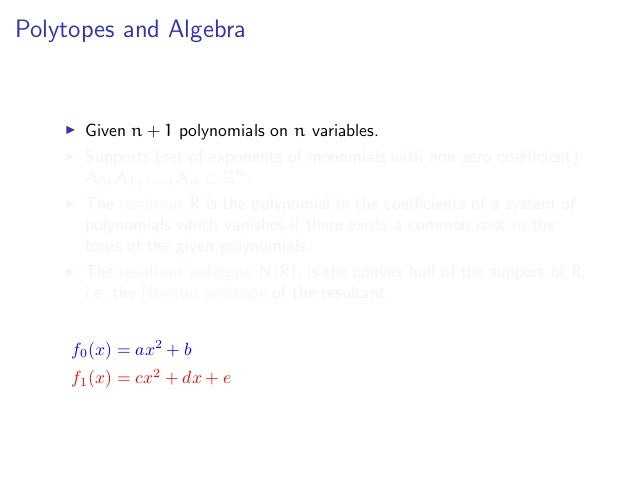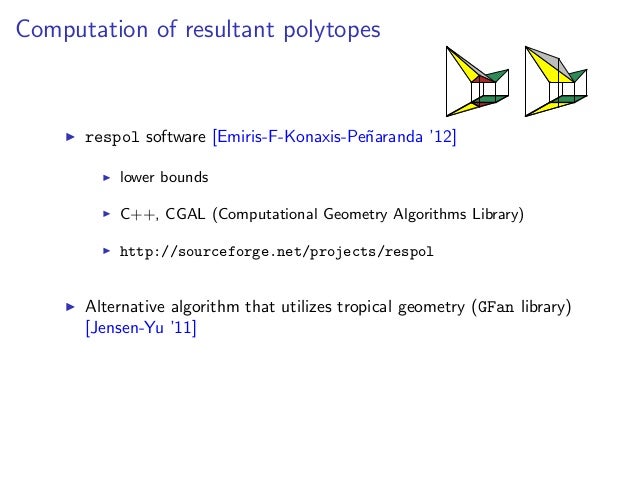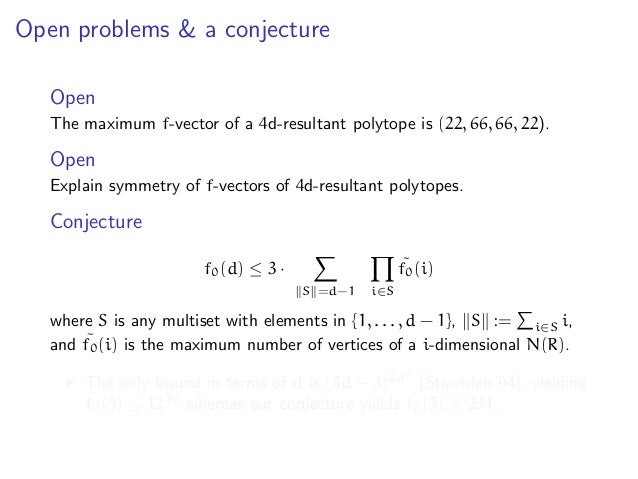Resultant Polynomials Algorithm
Let R resxAB denote the resultant of A and B taken with respect to x. The interest of this result in the case of the polynomials is that there is an efficient algorithm to compute the polynomials u and v This algorithm differs from Euclids algorithm by a few more computations done at each iteration of the loop.

Resultant Matrix Of Hdp 2 Download Scientific Diagram
In this paper we report on the recent progress in computing bivariate polynomial resultants on Graphics Processing Units GPU Given two polynomials in xy our algorithm first maps the polynomials to a prime field Then each modular image is processed individually The GPU evaluates the polynomials at a number of points and computes univariate modular resultants in parallel The remaining.

Resultant polynomials algorithm. In normal matrix operations in linear algebra one is often faced with the task of computing determinants. Poisson default the resultant is computed recursively through the Poisson Formula see 1 Theorem 34. Fx x2 - 2x - 1 gx x2 - 3.
Polynomials and Newton polytopes I The support of a polynomial f is the set of exponents of its monomials with non-zero coecient. For such p and q in Kxyboth of degree d in x and n in y the algorithm computes the resultant with respect to yusing n21d1o1arithmetic operations in K where two n n matrices are multiplied using Onoperations. The algorithm can also be used for interpolating polynomials from their values and expanding symbolic determinants.
Then each modular image is processed individually. Furthermore it is possible to come up with tight bounds on the running time and storage requirements of the algorithm. It is therefore called extended GCD algorithm.
The GPU evaluates the polynomials at a number of points and computes univariate modular resultants in parallel. Then each modular image is processed individually. Another difference with Euclids algorithm is that it also uses the quotient denoted quo of the Euclidean division instead of.
Ijj which is tosay the resultant is the product of either polynomial evaluated at each root includingmultiplicity of the other polynomial. In particular we present efficient algorithms for computing the resultant of a system of polynomial equations whose coefficients may be symbolic variables. This chapter presents polynomial resultants approaches starting from the resultants of two polynomials known as the Sylvester resultants to the resultants of more than two polynomials in several variables known as multipolynomial resultants.
If m 0 the resultant is an 0. Given two polynomials in xy our algorithm first maps the polynomials to a prime field. Multipolynomial ResultantsGiven n homogeneous polynomial in n unknowns the resultant of the given system of equations is a polynomial in the coefficients of the given equations.
Our approach is conceptually simple yet radically di erent from previous ones. As a result the algorithm may report fewer. Also If you could give me another examples that you might think it could help me understant this concept would be great.
To see that it is incorrect consider the following two polynomials in Qx. The remaining combine stage of the algorithm is executed sequentially on the host machine. Resultantfg 4 whereas the correct result is.
This is an option that determines which algorithm will be used to compute the resultantThere are currently four algorithms implemented. In particular we present efficient algorithms for computing the resultant of a system of polynomial equations whose coefficients may be symbolic variables. Macaulay the resultant is computed as a Macaulay resultant ie.
The calculator displays Sylvester matrix for input polynomials for reference only since it uses another algorithm based on Euclidean division. We show that SRA has an asymptotic complex-ity comparable to Berlekamps well-known trace algorithm for large degree polynomials. I know a little bit about the resultant of two polynomials but I couldnt find any example whatsoever.
An algorithm is presented for computing the resultant of two generic bivariate polynomials over a fieldK. Moreover we use multipolynomial resultants for computing the real or complex solutions of non-linear polynomial. Finally we use the symbolic elimination algorithm.
A0 and B bnxn bn 1x n 1. INTRODUCTION Let A amx m am 1x 1. Then the algorithm given above computes that.
In this paper we introduce the Successive Resultant Algorithm SRA a new de-terministic algorithm to solve this problem. As a ratio of two determinants see 1 Theorem 49. The evaluation of numerical interpolation points and the solution of linear equations.
The resultant can be calculated as the determinant of Sylvester matrix composed of the polynomials coefficients. Konaxis Dept Informatics Telecoms University of Athens currently with Univeristy of Crete EuroCG 2012 Assisi Perugia Italy 20March2012. This approach avoids symbolic computing whose computation complexity is usually very high furthermore both of these.
In practice h2z2 and h3z2 maybe nonzero polynomials but for the choice of r2 where h2r2 h3r2 O the algorithm assumes them as zero polynomials and proceeds. On the basis of the principle of polynomial interpolation an algorithm framework is proposed to compute the resultant polynomials which contains the following two major steps. Given two polynomials in xy our algorithm first maps the polynomials to a prime field.
The GPU evaluates the polynomials at a number of. Their applications to least squares approach. Exact and approximate algorithms for resultant polytopes Vissarion Fisikopoulos Joint work with IZ.
Sylvesters resultant polynomial resultants modular algorithms probabilistic algorithms. Finally the reader should note what happens inthe case that the two polynomials share a root as outlined in the following lemma. So I was wondering If you could illustrate the process of finding the resultant of two polynomials for f x3-2x4 and g x5x3-2x4.
The algorithm can also be used for interpolating polynomials from their values and expanding symbolic determinants. Porting this stage to the graphics hardware is an object of ongoing research. The calculator has a modified version of the resultant computation algorithm published in Computer Algebra and Symbolic Computation.
B 0 be two non-zero polynomials in x over a commutative ring R of degrees m and n respectively. However this algorithm is incorrect though I am not sure where the bug is.

Intersection And Projection Of Two Ellipses Algorithm For Computing The Download Scientific Diagram

Intersection And Projection Of Two Ellipses Algorithm For Computing The Download Scientific Diagram

Combinatorics Of 4 Dimensional Resultant Polytopes

Leaving Cert Physics Notes Vectors And Scalars Physics Notes Physics Notes

Simple Mathematical Model Of The Hip Joint Resultant Force F R And Download Scientific Diagram

Combinatorics Of 4 Dimensional Resultant Polytopes
Https Www Sciencedirect Com Science Article Pii S1474667017446301 Pdf Md5 2f608cb7ade5fcb2fc23f11bb46d5942 Pid 1 S2 0 S1474667017446301 Main Pdf
Https Www Sciencedirect Com Science Article Pii S1474667017446301 Pdf Md5 2f608cb7ade5fcb2fc23f11bb46d5942 Pid 1 S2 0 S1474667017446301 Main Pdf
Https Dl Acm Org Doi Pdf 10 1145 362835 362839

Polynomials Content Evaluation Root Finding Root Bracketing Interpolation
Https Arxiv Org Pdf 1905 04356
Https Www Sciencedirect Com Science Article Pii S1474667017446301 Pdf Md5 2f608cb7ade5fcb2fc23f11bb46d5942 Pid 1 S2 0 S1474667017446301 Main Pdf

Polynomials Content Evaluation Root Finding Root Bracketing Interpolation

How To Calculate Resultant Of Two Polynomials Without Knowing The Roots Mathematics Stack Exchange

Combinatorics Of 4 Dimensional Resultant Polytopes
Https Projecteuclid Org Download Pdf 1 Euclid Bams 1183500034

Pdf Dixon Resultant S Solution Of Systems Of Geodetic Polynomial Equations

Polynomials Content Evaluation Root Finding Root Bracketing Interpolation

Intersection And Projection Of Two Ellipses Algorithm For Computing The Download Scientific Diagram
Post a Comment for "Resultant Polynomials Algorithm"